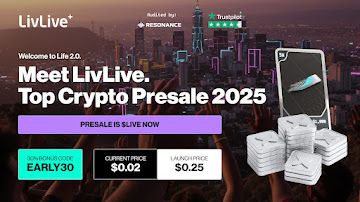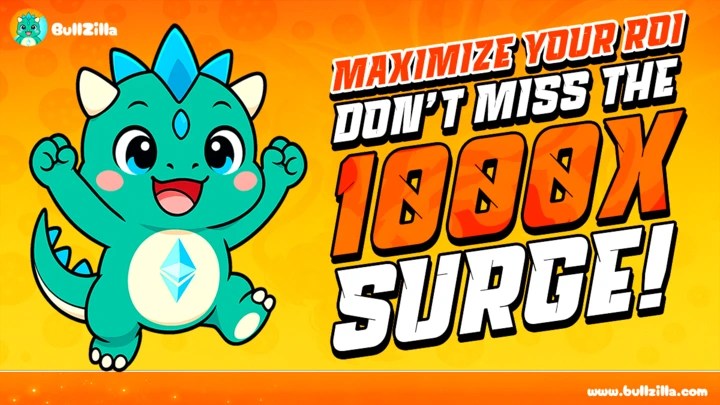Here’s Why Community Members Leaving Pepe Coin Are Rushing Into LivLive ($LIVE) This Week
Top coin to buy this week discussions are taking over the crypto space as October 2025 kicks off with high volatility and hotter opportunities. While Bitcoin holds steady and Solana ($SOL) shows consistent growth, a fresh entry, LivLive ($LIVE), is capturing every crypto chat feed. Early adopters are shifting toward real-world utility tokens that combine lifestyle, movement, and digital rewards into one ecosystem. LivLive’s surge in visibility hints that this might be the next big entry before 2026 begins.
Crypto trends this week show a decisive shift away from speculative hype toward function-based projects. LivLive ($LIVE) has quickly positioned itself as the bridge between real actions and blockchain rewards. As Q4 continues to unfold, experts naming it the top coin to buy this week are betting on a massive ROI opportunity that merges fitness, social validation, and token-based incentives all into one lifestyle economy.
LivLive ($LIVE): Transforming Daily Actions into Real Rewards
LivLive ($LIVE) isn’t built around short-term hype; it’s built for real-life integration. It functions as a real-world operating system that rewards daily activities—walking, shopping, attending events, or leaving reviews—with $LIVE tokens. By merging augmented reality, blockchain technology, and wearable devices, LivLive converts human presence into measurable value.
This is why LivLive is regarded as the top coin to buy this week. Its unique design gives users control over their lifestyle data while generating rewards through verified engagement. With a transparent token distribution and only 5% reserved for the team, LivLive creates a fair ecosystem where participation is genuinely rewarded.
LivLive ($LIVE) Presale Price, ROI Scenario, and Bonuses
The LivLive presale started strong, raising over $2 million in Stage 1 at $0.02 per token, with 130+ holders already participating. The next stage is priced at $0.04, and the launch price is set at $0.25, showing a clear opportunity for massive early ROI. A $5,000 buy-in today could easily turn into $62,500 at launch, marking over 12x returns even before staking or bonuses.
Buyers using the EARLY30 bonus code receive 30% extra tokens, instantly enhancing their total holdings. Key features include 50% guaranteed mining bonus, $2.5M Treasure Vault access, refer and earn rewards, and a 65% supply allocation for the community (25% presale + 40% mining). These benefits underline why LivLive is being recognized as the top coin to buy this week before the next stage price doubles.
Pepe Coin Price Today: Market Cooldown After Previous Rally
Pepe Coin (PEPE) price today sits at $0.00006881, showing a 4.65% decline in the past 24 hours, according to the latest news data. Despite once being a favorite among meme enthusiasts, the market cap of $2.89 billion now appears to be flattening, signaling that much of its explosive run may already be priced in.
According to Pepe Coin latest news, the token’s trading volume surged 17.33% to $543.4 million in 24 hours, yet the trend remains bearish overall. With 490.64K holders and a total supply nearly maxed at 420.68T PEPE, community members are seeking alternatives with higher growth potential and utility. LivLive ($LIVE), with its real-world value proposition, stands out as a logical next stop for those moving away from speculative assets.
Solana ($SOL) Price and Latest News: October 2025 Shows Steady Growth
Solana ($SOL) continues to hold its spot as a leading blockchain performer. The price today hovers around $165, with a 24-hour gain of 2.3%, reflecting growing confidence in its underlying technology. In the latest news, Solana’s network recently surpassed 250 million total transactions, further solidifying its reputation as a scalable and efficient chain.
Beyond the price, Solana’s NFT ecosystem remains strong, recording over $55 million in trading volume this week, as per the latest reports. DeFi protocols built on Solana have seen a 12% increase in total value locked (TVL), showing its growing use across real-world finance. However, with much of its upside already realized, many early adopters are now exploring emerging projects like LivLive ($LIVE) where growth potential is still exponential.
Why LivLive ($LIVE) Is Set to Redefine Utility Tokens in 2025
LivLive’s biggest advantage lies in its proof-of-action model, where engagement directly leads to tokenized rewards. Whether scanning a QR code, reviewing a product, or attending an event, every verified action earns $LIVE. This structure transforms real-world time into measurable value.
Businesses also benefit through LivLive’s LiveRep system, which verifies customer interactions and feedback on-chain. This innovation creates transparency between brands and their audiences, something lacking in traditional loyalty systems. It’s one of the many reasons analysts are calling LivLive the top coin to buy this week, as it blends entertainment, transparency, and income potential.
LivLive ($LIVE): Lifestyle Rewards Meet Blockchain Power
Unlike typical crypto projects, LivLive ($LIVE) directly connects digital and physical experiences. Users can earn tokens through fitness, shopping, social missions, and even local event participation. This system isn’t theoretical—it’s functional. The LivLive wristband authenticates activity and unlocks exclusive AR challenges that reward participation with tokens and NFTs.
The LivLive presale also gives exclusive entry into the $2.5M Treasure Vault Giveaway, featuring luxury prizes and 300+ winners. With each presale stage doubling in price and mining bonuses locked at 50%, the early-entry advantage is substantial. Add the EARLY30 bonus for 30% extra tokens, and LivLive becomes the top coin to buy this week for anyone looking to maximize gains before launch.
Conclusion: Could LivLive ($LIVE) Be the Top Coin to Buy This Week?
Pepe Coin’s price drop and Solana’s steady performance highlight how the market is shifting toward tokens that blend innovation with tangible use. LivLive ($LIVE) stands out as a rare project that rewards real-world activity while offering strong tokenomics and exclusive incentives. For those searching the market for the top coin to buy this week, LivLive is where excitement meets long-term potential.
Joining the LivLive presale now, using the EARLY30 code, offers 30% extra tokens, 50% mining bonuses, and entry into the Refer and Earn system. With fast-growing adoption and a community-first design, LivLive ($LIVE) positions itself as one of the most promising projects of Q4 2025—proof that living life actively can finally pay in crypto.
Find Out More Information Here
Website: www.livlive.com
X: https://x.com/livliveapp
Telegram Chat: https://t.me/livliveapp
Disclaimer: This is a paid post and should not be treated as news/advice. LiveBitcoinNews is not responsible for any loss or damage resulting from the content, products, or services referenced in this press release.
The post Here’s Why Community Members Leaving Pepe Coin Are Rushing Into LivLive ($LIVE) This Week appeared first on Live Bitcoin News.
You May Also Like

Wall Street Loves These 5 Cryptocurrencies: How Much Could $1,000 Grow if You Held for the Next 6 Months — $KPG Round 3 Presale at $0.029

August Crypto Market Review: ETH Leads the Rise, Institutional Funding and Macro Factors Dominate Market Trends
